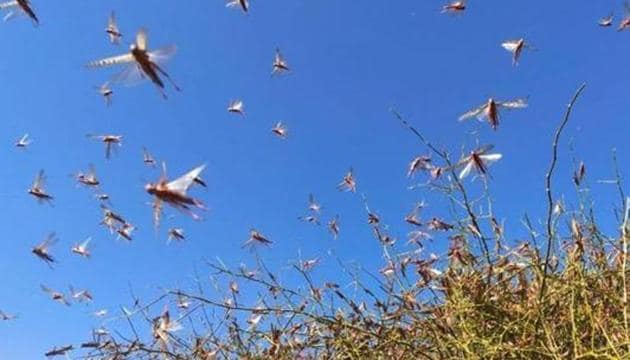FAO may declare locust invasion a ‘plague’ if it takes a turn for the worse by end of 2020
One of the options with farmers is to dig trenches around their farms to prevent hoppers from entering. Making noise can scatter locusts but they prevent focused control operations by authorities as the insects move in different directions.
The United Nations’ Food and Agriculture Organisation (FAO) may declare the locust invasion a “plague” if it takes a turn for the worse by end of this year following successful breeding in India, Pakistan, and in west Africa. The locust invasion has been currently categorised as an “upsurge” by FAO.

The Union Agriculture Ministry’s Locust Warning Organisation (LWO), headquartered in Jodhpur, has sprayed Malathion 96 and Chlorpyrifos, both organophosphate pesticides, to control the locust invasion across states. Both pesticides are extremely toxic and high exposure may cause nausea, dizziness, and even death in humans. It can also impact soil fertility by altering the ecological balance.
“Unfortunately, spraying of chemical insecticides is the only effective method, when desert locusts are in such large numbers. There are biopesticides that are safe ways of controlling them but may not be as effective. FAO doesn’t encourage control of desert locusts by farmers. State or federal teams that are trained in locust invasion management should do it with safety equipment,” said Keith Cressman, senior desert locust forecasting officer at FAO, during a webinar organised by the Delhi-based Centre for Science and Environment (CSE) on Friday.
One of the options with farmers is to dig trenches around their farms to prevent hoppers from entering. Making noise can scatter locusts but they prevent focused control operations by authorities as the insects move in different directions.
Cressman said the current severe locust invasion is linked to climate change-induced aberrations in rainfall. “There was good breeding in India last year, the monsoon was protracted, which allowed a further increase in locust populations. The drying vegetation in southwest Pakistan also led to them reaching India a month in advance,” he said. India was alerted by FAO last year about the possibility of waves of invasions and that LWO authorities are in a position to control these waves. “India is well equipped. It has the oldest national locust programme in the world.”
The desert locust was expected to remain limited to its desert habitat, but it scattered to Madhya Pradesh (MP), Uttar Pradesh (UP), and Maharashtra because of the strong north-westerly winds following super cyclone Amphan last week.
There are two situations India is currently staring at: with the onset of monsoon rains the locusts, which have now scattered to MP, UP, Maharashtra from Rajasthan, will come back to their summer breeding sites in the desert along the India-Pakistan border. “They will be flying back and forth with the winds till monsoon arrives,” he added.
The other forecast that FAO has made is that with the southwest monsoon winds desert locusts that bred in the Horn of Africa will travel to Rajasthan across the Indian Ocean in June.
Richard Mark Mbaram, a technical adviser to the ministry of agriculture, Nigeria, said, “spraying of insecticides is compounding environmental problems in the Horn of Africa. We do not have the wherewithal to undertake these measures at the scale required, we need aircraft to spray, expertise to spray. Biotechnological interventions should be considered…locust invasions are an existential challenge if they are allowed to exist in the coming years.”
“Except for Malathion 96, the rest of the pesticides are highly poisonous. They are red labelled. They are meant for locust control in desert areas, which are largely uninhabited. But the same pesticides are being sprayed on in areas with habitation and with water bodies. These pesticides will drift and residue will remain. They’ll definitely disturb the ecological balance of the area and kill natural enemies — pests, which can counter other crop pests. We can expect an outbreak of other pests,” said GV Ramanjaneyulu, executive director at the Hyderabad-based Centre for Sustainable Agriculture. “Desert locusts don’t multiply in non-desert areas so there is no point in spraying toxic pesticides in such large quantities in other states. They have a short life cycle and will die in due course. The government must consider biocontrol agents,” he added.
“We’ve conducted control operations in 47,000 hectares in Rajasthan, Gujarat, and MP by spraying pesticides,” said KL Gurjar, deputy director, LWO.
“A locust swarm is scattered near Jhansi in UP. But there is no clear indication that some of them will fly towards Delhi,” Gurjar added.
Get Current Updates on India News, Lok Sabha Election 2024 live, Infosys Q4 Results Live, Elections 2024, Election 2024 Date along with Latest News and Top Headlines from India and around the world.



